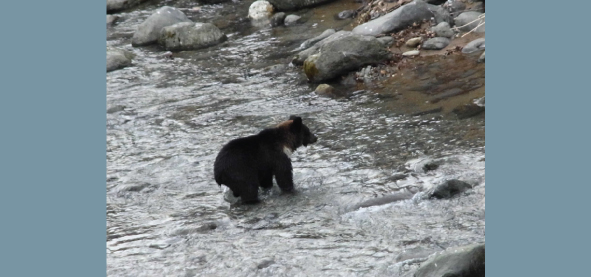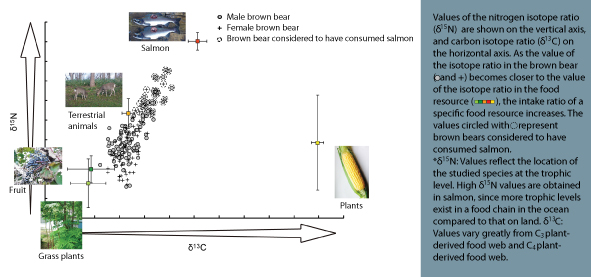Feeding Patterns of Non-Salmon-Eating Brown Bears in Shiretoko Analyzed Using Stable Isotopes
Research Press Release | September 16, 2014
-
 Brown bear in search of salmon. A brown bear searching for salmon in a river. Environment loss of areas where brown bears can freely catch salmon is considered to have caused a decrease in the consumption of salmon. Photograph taken at a river in the Shiretoko Peninsula in the fall of 2012.
Brown bear in search of salmon. A brown bear searching for salmon in a river. Environment loss of areas where brown bears can freely catch salmon is considered to have caused a decrease in the consumption of salmon. Photograph taken at a river in the Shiretoko Peninsula in the fall of 2012. -
 Isotope data of brown bears and their food resources.
Isotope data of brown bears and their food resources.
| Press Release | ||
|---|---|---|
| Key Points |
・Of the total nutrient sources for brown bears in the Shiretoko region of Hokkaido, salmon account for a very low percentage—approx. 5%. ・Of the total nutrient sources for brown bears in the relatively undeveloped Shiretoko World Heritage Site, salmon accounted for a percentage more than double that of brown bears outside the site. ・This difference suggests that river structures that block salmon migration and land-use changes in downstream areas affect the feeding patterns of brown bears in the region. |
|
| Overview |
Salmon have a unique life cycle. They are born in rivers, migrate downstream to the ocean where they grow and store up nutrients, and then return to the rivers to spawn. When they return, they bring with them ocean-derived compounds such as nitrogen and phosphorus, which are valuable nutrient sources for various riverside plants and animals, including brown bears. Brown bears especially consume a large amount of salmon, playing a role as a carrier of marine-derived nutrients to the land (Fig. 1). Both brown bears and salmon are distributed throughout the Hokkaido region. However, previous studies have suggested that salmon may no longer be the primary nutrient source for brown bears. Hence in this study, we carried out stable isotope analysis in order to determine the feeding patterns of brown bears in the Shiretoko Peninsula and the Shiretoko World Heritage Site, and examined the conditions which may have led to a change in the amount of salmon consumed by brown bears. The advantage of determining feeding patterns using stable isotopes is that the long-term feeding pattern of each individual animal can be estimated. In this study, we considered two factors which may cause change in the amount of salmon consumed by brown bears; 1) age and gender of brown bears, and 2) the presence/absence of developed areas in their habitat and estimated the consumption amount of salmon by brown bears under each condition. According to the results, i) salmon account for approx. 5% of the total nutrient sources for brown bears in the Shiretoko region, ii) the consumption amount of salmon is lower in females raising cubs, and iii) the percentage of salmon in the total nutrient sources for brown bears in relatively undeveloped areas is more than double that of brown bears in developed areas. This suggests that the symbolic brown bear-salmon relationship seen in Hokkaido is disappearing. This study was carried out with the financial assistance from the Hokkaido Government, the Sumitomo Foundation, and Grants-in-Aid for Scientific Research. |
|
| Inquiries |
Junko Morimoto, Associate Prof., Research Faculty of Agriculture, Hokkaido University TEL: +81-11-706-2515 E-mail: jmo1219@for.agr.hokudai.ac.jp |
|
|
Japanese Link |
サケを食べない知床のヒグマ~安定同位体による食性分析~ | |
| Publications | Using stable isotopes to understand the feeding ecology of the Hokkaido brown bear (Ursus arctos) in Japan (URSUS tentative release 2014.12) | |
